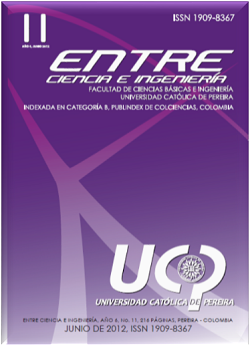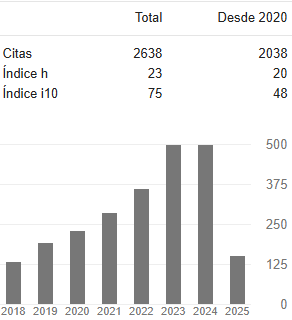Estudio de Propuestas para Soportar Ingeniería de Tráfico en Internet
DOI:
https://doi.org/10.31908/19098367.664Palabras clave:
Internet, ingeniería de tráfico, rendimientoResumen
La ingeniería de tráfico es un proceso de suma importancia para la evaluación y optimización del rendimiento de redes IP en operación. Este es un problema abierto pues aún no hay soluciones definitivas en las normas actuales de Internet. Por tanto, en este artículo se presenta un estudio riguroso sobre diferentes recomendaciones dadas por la IETF y aproximaciones propuestas por diferentes investigadores en la última década, tendientes a especificar y dar soporte al proceso de ingeniería de tráfico sobre Internet. Con la investigación realizada se provee una contextualización general sobre el modelo de un sistema de ingeniería de tráfico, la taxonomía y las diferentes problemáticas que han sido estudiadas, con el fin de mejorar el rendimiento en dichas redes, además esta información es un insumo valioso como punto de partida para la generación de una nueva propuesta que permita soportar ingeniería de tráfico sobre Internet.
Descargas
Referencias
Abrahamsson H. and Bjorkman M. ( 2009). Robust Traffic Engineering using L-balanced Weight-Settings in OSPF/IS-IS. Broadband Communications, Networks, and Systems, 2009. BROADNETS 2009. Sixth International Conference 1-8.
Almes G.; Kalidindi S. and Zekauskas M. (1999a). A One-way Packet Loss Metric for IPPM. IETF RFC2680.
Almes G.; Kalidindi S. and Zekauskas M. (1999b). A One-wayDelay Metric for IPPM. IETF RFC2679.
Andersson L; Minei I. and Thomas B. (2007). LDP Specification. IETF RFC5036.
Aukia P. et al. (2000). RATES: A Server for MPLS Traffic Engineering. IEEE Network, 14(2), 34-41.
Awduch D. et. al. (1999). Requirements for Traffic Engineering Over MPLs. IETF RFC2702.
Awduche D. et al. (2001). RSVP-TE: Extensions to RSVP for LSP Tunnels. IETF RFC3209.
Awduche D. et al. (2002). Overview and Principles of Internet Traffic Engineering. IETF RFC3272.
Awduche Daniel O. (1999). MPLS and Traffic Engineering in IP Networks. IEEE communications Magazine, 37(12), 42-47.
Bagula A. (2004). Online Traffic engineering: A Hybrid IGP+MPLS Routing Approach. QofIS 2004, LNCS 3266, pp. 134-143. SpringerVerlag Berlin Hidelberg.
Bagula A. (2005). Hybrid IGP+MPLS Routing in Next Generation IP Networks: An Online Traffic Engineering Model. SpringerVerlag Berlin Heidelberg 2005, 325-338.
Balakrishnan H. and Seshan S. (2001). The Congestion Manager. IETF RFC3124.
Barakovic J.; Bajric H. and Husic A. (2007). QoS Design Issues and Traffic Engineering in Next Generation IP/MPLS Network. 9th International Conference on Telecomunications, 203-209.
Bessa Maia J.; Da Silva A.; Silva J. and Cunha P. (2009). A Methodology of Traffic Engineering to IP Backbone. Computer Science
Bhatnagar S.; Ganguly S.; and Nath B. (2005). Creating Multipointto-Point LSPs for Traffic Engineering. IEEE communications Magazine, 43(1), 95-100.
Blak S. et al. (1998). An Architecture for Differentiated Services. IETF RFC2475.
Boutaba R.; Szeto W.; and Iraqi Y. (2002). DORA: Efficient Routing for MPLS Traffic Engineering. J. Network and Sys. Mgmt, 10(3), 309-325.
Braden R. et al. (1997). Resource ReSerVation Protocol (RSVP) Version 1 Functional Specification. IETF RFC2205.
Braden R.; Clark D. and Shenke S. (1999). Integrated Services in the Internet Architecture: an Overview. IETF RFC1633.
Brownlee N.; Mills C. and Ruth G. (1999.). Traffic Flow Measurement: Architecture. IETF RFC2722.
Elwalid A.; Jin C.; Low S.; and Widjaja I. (2001). MATE: MPLS Adaptive Traffic Engineering. Proc. IEEE INFOCOM, 1300-1309.
Ericsson M.; Resende M. and Pardalos P. (2002). A Genetic Algorithm for the Weight Setting Problem in OSPF Routing. J. Combinatorial Optimization, 6(3), 299-333.
Feamster N. et al. (2003). Guidelines for Interdomain Traffic Engineering. ACM SIGCOMM, 33(5), 19-30.
Feldmann A. and Rexford J. (2001). IP Network Configuration for Intradomain Traffic Engineering. IEEE Network, 15(5), 46-57.
Feldmann A. et al. (2000). NetScope: Traffic Engineering for IP Networks. IEEE Network, 14(2), 11-19.
Fortz B. (2002). On the evaluation of the reliability of OSPF routingh in IP networks.
Fortz B. and Thorup M. (2000). Internet Traffic Engineering by Optimizing OSPF Weights. Proc. IEEE INFOCOM, 519-528.
Fortz B.; Rexford J. and Thorup M. (2002). Traffic Engineering with Traditional IP Routing Protocols. IEEE communications Magazine, 40(10), 118-124.
Gao L. and Rexford J. (2001). Stable Internet Routing without Global Coordination. IEEE/ACM Trans. Networking, 9(6), 681-692.
Gojmerac I.; Ziegler T.; Ricciato F. and Reichl P. (2003). Adaptive Multipath Routing for Dynamic Traffic Engineering. Proc. IEEE GLOBECOM, 3058-3062.
Gunnar A. (2011). Aspects of Proactive Traffic Engineering in IP Networks. Thesis Doctoral, Stockholm Sweden.
Gunnar A. and Johansson M. (2011). Cautious Weight Tuning for Link State Routing Protocols. SICS Tecnical Report T2011:01 ISSN1100-3154.
Gunnar A.; Abrahamsson H. and Soderqvist M. (2005). Performance of Traffic Engineering in Operational IP-Networks - an experimental Study. Proceedings of the 5th IEEE International Workshop on IP Operations and Management IPOM 2005, Barcelona Spain.
Gunnar A.; and Johansson M. (2010). Robust load balancing under traffic uncertainty-tractable models and efficient algorithms. Telecommunications Systems Journal, In Press.
Gunnar A.; Johansson M. and Telkamp T. (2004). Traffic Matrix Estimation on a Large IP Backbone - a Comparison on Real Data. Procedings of the third ACM SIGCOMM Conference on Internet Measurements IMC 2004, Taormina, Sicily, Italy
Guo H.; Gao S. and Zhang H. (2009). Inter-Domain Routing With As Number: A Traffic Engineering Perspective. IEEE, 1-4.
Jamoussi B.; Andersson L.; Collon R. and Dantu R. (2002). ConstraintBased LSP Setup using LDP. IETF RFC3212.
Johansson M. and Gunnar A. (2006). Data-driven traffic enginnering: techniques, experiences and challeges. Procedings of the third International Conference on Broadband Communications, Networks and Systems Broadnets, California.
Kar K.; Kodialam M.; and Lakshman V. (2000). Minimum Interference Routing of Bandwidth Guaranteed Tunnels with MPLS Traffic Engineering Applications. IEEE JSAC, 18(12), 2566-2579.
Kodialam M.;an Lakshman V. (2000). Minimum Interference Routing with Applications to MPLS Traffic Engineering. 884-893.
Lad M.; Han Park J.; Refice T and Zhang L. (2008). A Study of Internet Routing Stability Using Link Weight. Technical Report Computer Science Department, University of California.
Li Ch.; Li P. and Mohammed T. (2007). An Optimal MPLS-TE Solution to Route Selection and Redistribution on Congested Networks. IEEE computer Society. International Conference on Networking, Architecture and Storage (NAS 2007), 69-76.
Mahdavi J. and Paxson V. (1999.). IPPM Metrics for Measuring Connectivity. IETF RFC2678.
Mohamad I.; Wan T.; Alzyoud F. and Sumari P. (2009). Optimizing the MPLS Support for Real Time IPv6-Flows using MPLS-PHS Approach. TENCON 2009 - 2009 IEEE Region 10 Conference 1-6.
Network Simulator NS-2. from http://nsnam.isi.edu/nsnam/index.php/ Main_Page
Oliveira J.; Martinelli F.; and Scoglio C. (2002). SPeCRA: A Stochastic Performance Comparison Routing Algorithm for LSP Setup in MPLS Networks. Proc. IEEE GLOBECOM, 2190-2194.
Oliveira J.; Scoglio C.; Akyildiz F.; and Uhl G. (2004). New Preemption Policies for Diffserv-Aware Traffic Engineering to Minimize Rerouting in MPLS Networks. IEEE/ACM Trans. Networking, 12(4), 733-745.
Paxson V.; Almes G.; Mahdavi J. and Mathis M. (1998.). Framework for IP Performance Metrics. IETF RFC2330.
Pham H. and Lavery B. (2003). Hybrid Routing for Scalable IP/ MPLS Traffic Engineering. IEEE International Conference on Communications, 2003. ICC ‘03., 1, 332-337.
Pioro M. and Medhi D. (2004). Routing, Flow, and Capacity Design in Communication and Computer networks. Morgan Kaufmann Publishers, ELSEIVER, 170.
Quoitin B.; Pelsser C. and Swinnen L. (2003). Interdomain Traffic Engineering with BGP. IEEE Communications Magazine, 41(5), 122- 128.
Rétvári G. and Cinkler T. (2004). Practical OSPF Traffic Engineering. IEEE communications Letters, 8(11), 689-691.
Rétvári G.; Szabó R.; and Bíró J. (2004). On the Representability of Arbitrary Path Sets as Shortest Paths: Theory, Algorithms and Complexity. Proc. IFIP NETWORKING, 1180-1191.
Rosen E.; Viswanathan A. and Callon R. (2001). Multiprotocol Label Switching Architecture. IETF RFC3031.
Saito H.; Miyao Y.; and Yoshida M. (2000). Traffic Engineering using Multiple Multipoint-to-Point LSPs. Proc. IEEE INFOCOM, 894-901.
Scoglio C. et al. (2004). TEAM: A Traffic Engineering Automated Manager for DiffServ Based MPLS Networks. IEEE communications Magazine, 42(10), 134-145.
Shenke S.; Partridg C. and Guerin R. (1997). Specification of Guaranteed Quality of Service. IETF RFC2212.
Skivée F.; Balon S. and Leduc G. (2006). A Scalable Heuristic for Hybrid IGP/MPLS Traffic Engineering- Case Study on an Operational Network. Networks, 2006. ICON ‘06. 14th IEEE International Conference on Telecommunications, 2, 1-6.
Tabatabaee V. et al. (2005). Differenciated Traffic Engineering for QoS Provisioning. Proc. IEEE INFOCOM, 2349-2359.
Trimintzios P. et al. (2001). Engineering the Multi-Service Internet: MPLS and IP-based Techniques. Proc. of the IEEE International Conference on Telecommunications (ICT’2001), Bucharest, Romania, 3, 129-134.
Trimintzios P. et al. (2003). Quality of service provisioning trough traffic engineering with aplicability to IP-based production networks. Computer Communications, 26(8), 845-860.
Uhlig S. and Quoitin B. (2005). Tweak-it: BGP-based Interdomain Traffic Engineering for transit ASs. IEEE, 75-82.
Urvoy-Keller G.; Hébuterne G.; and Dallery Y. (2002). Traffic Engineering in a Multipoint-to-Point Network. IEEE JSAC, 20(4), 834-849.
Walkowiak K. (2004). Survivable Online Routing for MPLS Traffic Engineering. Proc. QoFIS, 288-297.
Wang J. et al. (2005). Edge Based Traffic Engineering for OSPF Networks. Comp. Networks, 48(4), 605-625.
Wang N.; Ho K.; Pavlou G. an Howarth M. (2008). An overview of routing optimization por internet traffic enginering. IEEE Communications 1st Quarter 10 No 1, 36-56.
Wang Y.; Wang Z. and Zhang L. (2001). Internet Traffic Engineering without Full Mesh Overlaying. INFOCOM2001, 565-571.
Wroclawski J. (1997). Specification of the Controlled-Load Network Element Service. IETF RFC2211.
Xiao X.; Hannan A.; Bailey B. and Ni L. (2000). Traffic Engineering with MPLS in the Internet. IEEE Network, 14(12), 28-33.
Xu K.; Liu H.; Liu J. and Shen M. (2011). One More Wight is Enough: Toward the Optimal Traffic engineering with OSPF. IEEE Computer Society. 31st International Conference on Distributed Computing Systems, 836-846.
Yang et al. (2005). On Route Selection for Interdomain Traffic Engineering. IEEE Network, 19(6), 20-27.
Yavatka R.; Pendaraki D. and Gueri R. (2000). A Framework for Policy-based Admission Control. IETF RFC2753.
Younis O.; and Fahmy S. (2003). Constraint-Based Routing in the Internet: Basic Principles and Recent Research. IEEE communications Surveys and Tutorials.
Zhang M.; Liu B. and Zhang B. (2010). Multi-Commodity Flow Traffic Engineering with Hybrid MPLS/OSPF Routing. Global Telecommunications Conference, 2009. GLOBECOM 2009. IEEE, 1-6.
Descargas
Publicado
Número
Sección
Licencia
Derechos de autor 2019 Entre Ciencia e Ingeniería

Esta obra está bajo una licencia internacional Creative Commons Atribución-NoComercial 4.0.



















